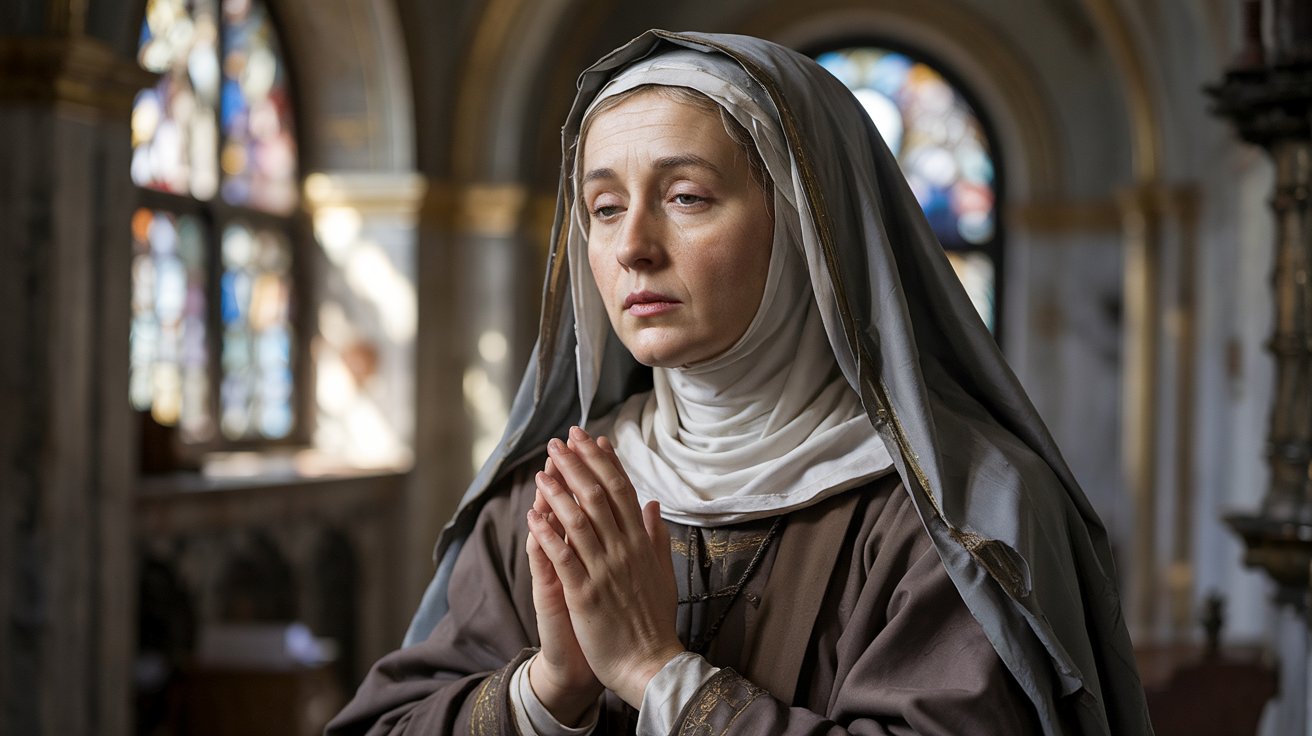Quick Reference Table
| Aspect | Details |
|---|---|
| Full Name | Saint Dymphna |
| Dates | 7th century (traditional accounts place her lifetime around this era) |
| Feast Day | May 15 |
| Titles & Epithets | “Lily of Éire” (in some traditions), Martyr for Chastity |
| Birthplace | Ireland (exact location uncertain, but traditionally in the region of Oriel or near modern-day Monaghan) |
| Major Shrine | Gheel (Geel), Belgium |
| Patronages | Mental illness, anxiety, depression, victims of incest, runaways, mental health professionals |
| Symbols | Sword (symbol of her martyrdom), lily (purity), occasionally shown defeating or driving away demons |
| Canonization | Recognized as a saint pre-congregation (popular devotion ratified by Church tradition) |
| Notable Attributes | Martyred by beheading, revered especially in the care of the mentally ill |
Introduction
Saint Dymphna is a 7th-century Irish virgin-martyr traditionally honored as the patron saint of those suffering from mental and emotional disorders. Although the historical record on her life is sparse, her legend recounts a story of steadfast faith and heroic virtue in the face of familial tragedy. Over the centuries, devotion to St. Dymphna has grown—particularly in regions of Europe, and later in the United States—where she is frequently invoked for her intercession in matters related to mental health and emotional well-being.
Life and Legend
Irish Origins
- Birthplace: Tradition places Saint Dymphna’s birth in Ireland during the early to mid-7th century. Her mother was a devout Christian, and her father, often named Damon in later retellings, was likely a pagan chieftain or minor king.
- Religious Upbringing: Dymphna’s mother ensured she was raised in the Christian faith. This upbringing imparted a deep piety and commitment to chastity.
Death of Her Mother and Subsequent Crisis
- Mother’s Passing: Dymphna’s mother died when Dymphna was still young. The father, stricken by grief and mental instability, began to suffer what some accounts describe as a psychological breakdown.
- Unholy Proposal: In his disordered grief, her father sought to marry Dymphna—believing she resembled her late mother. Horrified, Dymphna refused.
Flight to Gheel (Geel), Belgium
- Escape from Ireland: With the help of her spiritual director (often named Father Gerebran) and possibly other companions, Dymphna fled her homeland to avoid her father’s incestuous demands.
- Settling in Gheel: They traveled to present-day Belgium, eventually finding refuge near the town of Gheel (Geel). There, she devoted herself to prayer, works of charity, and remaining hidden from her father’s pursuit.
Martyrdom
- Discovery: Dymphna’s father located her in Gheel, aided by his retainers. He demanded that she return with him and submit to his demands.
- Refusal and Death: Dymphna resolutely refused. Enraged, her father beheaded both her and Father Gerebran. Tradition places her martyrdom at around age 15.
- Miraculous Aftermath: According to legend, local townspeople buried her remains. Reports of miracles and healings near her grave began soon after, especially for those with mental or emotional illnesses.
Early Veneration and the Shrine of Gheel
Discovery of Relics
- Later accounts mention that Dymphna’s tomb was eventually discovered, with relics identified as hers. A chapel was built in Gheel to honor her memory.
Growth of Pilgrimage
- Medieval Devotion: By the Middle Ages, Gheel had become a pilgrimage destination for those seeking cures or relief from mental afflictions.
- Unique Community Care: Over time, the town of Gheel became famous for its innovative and compassionate care of the mentally ill, who were welcomed into local homes. This tradition, inspired by St. Dymphna’s legacy, endures in certain forms to this day, making Gheel a historical pioneer in community-based mental healthcare.
Patronages and Symbolism
- Mental Health and Emotional Disorders
- Dymphna is widely invoked by those experiencing anxiety, depression, and other psychological conditions, as well as by mental health professionals who seek her intercession and guidance.
- Victims of Incest and Abusive Situations
- Since Dymphna was martyred in part due to her father’s incestuous desires, she is seen as a patron for those escaping or healing from sexual abuse within the family.
- Runaways
- Her flight from home and her father’s pursuit resonate with those forced to flee unsafe or abusive environments.
- Symbols
- Sword: Represents the manner of her martyrdom (beheading).
- Lily: A common emblem of purity, sometimes depicted alongside her or in her hands.
- Defeating Demons: In some artwork, she is shown in a posture suggestive of overcoming or driving away demonic or evil influences (symbolic of mental torments).
Feast Day and Liturgical Observance
- Feast Day: May 15 is observed in the Roman Catholic tradition as the Memorial of Saint Dymphna.
- Mass and Devotions: Parishes or chapels dedicated to her may hold special Masses or prayer services focusing on healing and support for those struggling with mental health challenges.
Prayers and Devotions to Saint Dymphna
Below are a couple of popular forms of devotion in her honor.
Prayer to Saint Dymphna for Mental Health
Prayer
Lord, our God,
you graciously chose St. Dymphna
as patroness of those afflicted with mental, emotional, and nervous disorders.
She is thus an inspiration and a symbol of charity to the thousands
who ask her intercession.
Please grant, Lord, through the prayers of this pure youthful martyr,
relief and consolation to all suffering such trials,
and especially those for whom we now pray.
(Mention intentions here…)
We beg You, Lord, to hear the prayers of St. Dymphna on our behalf.
Grant all those for whom we pray patience in their sufferings
and submission to Your divine will.
Fill them with hope, and grant them the relief and cure they so much desire.
We ask this through Christ our Lord.
Amen.
Chaplet of St. Dymphna
- A shorter chaplet or series of prayers (often consisting of 15 beads) may be recited, including petitions for peace of mind, healing, and protection from spiritual or mental anguish.
Timeline of Key Events
| Approx. Year | Event | Significance |
|---|---|---|
| 7th Century | Traditional date of Dymphna’s birth in Ireland | Marks the beginning of her life in a devout Christian household |
| 7th Century | Flight to Gheel with Father Gerebran | Attempts to escape her father’s incestuous intentions |
| 7th Century | Martyrdom in Gheel | Dymphna and Gerebran are killed, marking her as a virgin-martyr |
| Medieval Period | Recognition of her shrine and relics | Pilgrimages begin; miracles associated with healing of mental illnesses |
| Middle Ages | Gheel develops a tradition of caring for the mentally ill | Inspired by Dymphna’s example of compassion |
| Pre-Congregation | Popular canonization and recognition as a saint | Dymphna’s cult becomes well-established in Belgium and beyond |
| Modern Era | St. Dymphna invoked for mental health causes worldwide | Symbol of hope for those with mental and emotional disorders |
Conclusion
Saint Dymphna’s poignant story—rooted in familial tragedy yet culminating in a lasting legacy of mercy, care, and healing—continues to console and inspire believers. Though her exact historical details may be shrouded in legend, the reality of her devotion as patroness of the mentally ill is indisputable. Her feast day on May 15 remains an important occasion for praying for those afflicted with anxiety, depression, and other mental health struggles.
From the medieval pilgrims who flocked to Gheel to modern-day devotions practiced in parishes and private homes around the world, St. Dymphna’s intercession remains a beacon of hope. Her example reminds us that mental and emotional well-being is a sacred concern, calling for compassion, support, and faith in the face of profound personal challenges.






